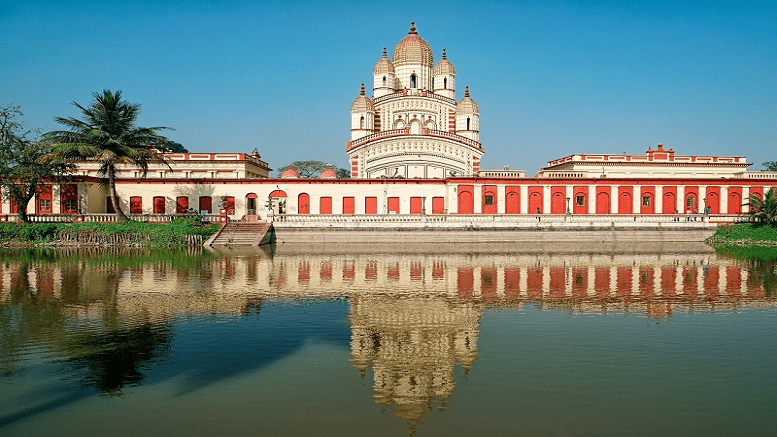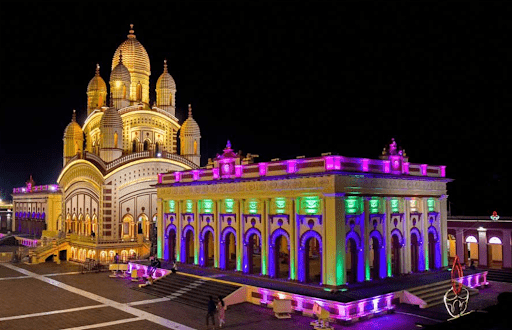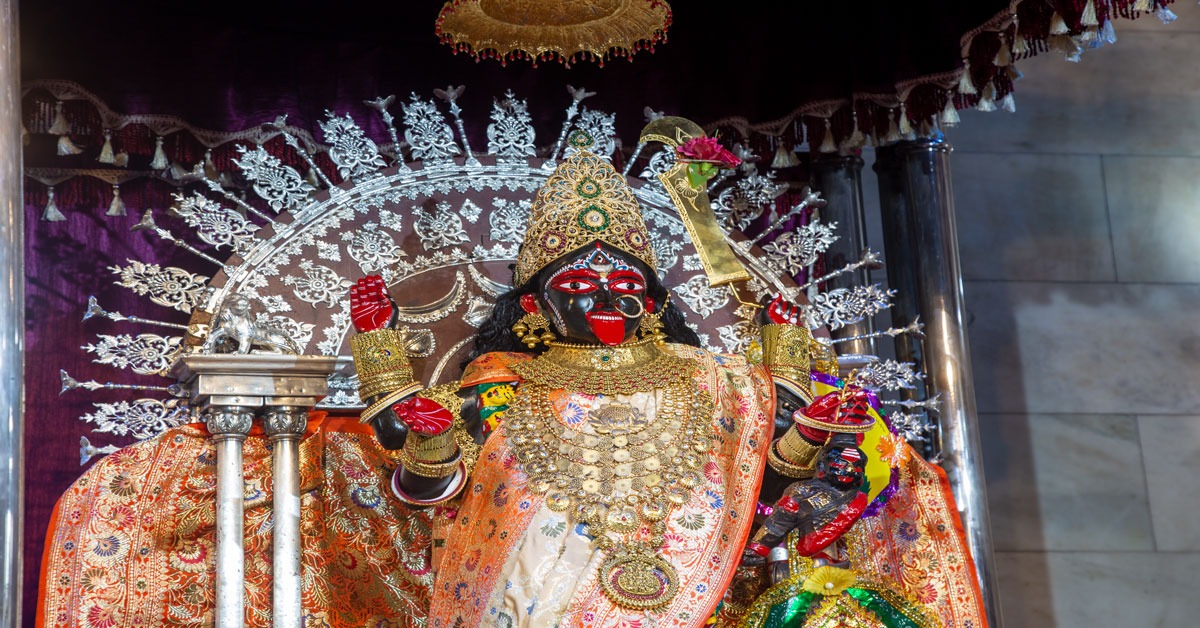
Dakshineswar Kali Temple, Kolkata, West Bengal
Dakshineswar Kali Temple or Dakshineswar Kalibari is a Hindu navaratna temple in Dakshineswar, Kolkata, West Bengal, India. Situated on the eastern bank of the Hooghly River, the presiding deity of the temple is Bhavatarini, a form of Mahadevi or Parashakti Adya Kali, otherwise known as Adishakti Kalika.
Historical background and Architectural splendor
Dakshineswar Kali Temple was built in 1855 by Rani Rashmoni, a philanthropist and devotee of Goddess Kali. The construction aimed to create a sacred space for devotees to worship Kali and was later supervised by the renowned mystic Sri Ramakrishna Paramahamsa.
The temple features traditional Bengali Navaratna architecture with a central shrine surrounded by smaller temples dedicated to various deities. The main temple has a distinctive nine-spired structure, showcasing the architectural brilliance of the time.The navaratna style includes nine spires symbolizing the nine planets, offering a unique and aesthetically pleasing design. The intricate detailing in the architecture reflects the cultural.
Positioned on the eastern bank of the Hooghly River, the temple offers a picturesque view of the river, enhancing the overall spiritual and aesthetic experience. and artistic heritage of Bengal.

Religious Significance
This temple stands as a profound symbol of religious significance in Hinduism. Dedicated to Goddess Kali, a formidable deity embodying the divine feminine energy and associated with destruction and regeneration, the temple has become a revered pilgrimage site. Its spiritual importance is deeply rooted in the life and teachings of Sri Ramakrishna Paramahamsa, a 19th-century mystic and saint who served as the chief priest of the temple. Ramakrishna's intense devotion to Kali and his subsequent spiritual enlightenment have left an indelible mark on the temple, attracting devotees from diverse backgrounds. The site is also associated with Sarada Devi, Ramakrishna's wife, adding another layer of spiritual significance. The temple serves as a beacon of universal harmony, where people of different faiths come together to seek spiritual understanding and unity. Hosting various festivals and rituals throughout the year, including the grand Kali Puja, the Dakshineswar Kali Temple stands not only as an architectural marvel with its traditional Bengali design but also as a cultural and spiritual sanctuary along the banks of the Hooghly River.

Festival and Celebrations
Here the the festivals celebrated are Kali Puja, Durga Puja, Sri Ramakrishna Jayanti, Snana Yatra, Birth Anniversary of Rani Rashmoni, Annual Jagadhatri Puja, Saraswati Puja, Dol Purnima, Guru Purnima and Navaratri Celebrations. Devotees and visitors immerse themselves in the joyous festivities and seek divine blessings during these auspicious occasions.
Surroundings area & attractions
- Belur Math: Located in close proximity, Belur Math is the headquarters of the Ramakrishna Math and Mission. It was founded by Swami Vivekananda, a disciple of Sri Ramakrishna Paramahamsa.
- Baranagar Math: Another center of the Ramakrishna Mission, Baranagar Math, is situated nearby. It holds historical significance in the life of Sri Ramakrishna.
- Adyapeath Temple: Adyapeath, a temple dedicated to Goddess Adya, is located in Dakshineswar. Devotees often visit this temple as part of their pilgrimage.
- Cossipore Udyanbati: The ancestral house of Rani Rashmoni, the founder of Dakshineswar Kali Temple. It is situated in Cossipore and holds historical importance.
- Pareshnath Jain Temple: A Jain temple dedicated to Lord Mahavir, known for its architectural beauty and serene ambiance.
- Nageshwarnath Temple : Dedicated to Lord Shiva, it is one of the oldest temples in Ayodhya.
- Guptar Ghat : Believed to be the spot where Lord Rama took Jal Samadhi, it holds spiritual significance.
- Swarg Dwar : The mythical gateway to heaven, it is said to be the spot where Lord Rama ascended to heaven.
- Dashrath Mahal : A historical site associated with King Dashrath, the father of Lord Rama.
Visitor information
Entry Fee: No fee
Timings :
- 6 am–12:30 pm
- 3:30–8:30 pm
Darshan Days- All days
Address:
Dakshineswar Kali Temple Dakshineswar, Kolkata, West Bengal 700076, India.
Notable Events and Incidents
- Temple Construction
- Ramakrishna Paramahamsa's Arrival
- Renovation and Restoration (2010-2015)
Connectivity :
- By Road: Well-connected by road; easily accessible by taxis, buses, and private vehicles.Located near Kolkata, the temple is a popular destination for local and out-of-town visitors.
- By Rail:Dakshineswar Railway Station is in close proximity to the temple. Regular train services connect Dakshineswar to major railway stations in Kolkata.
- By River: The Hooghly River offers boat services to Dakshineswar, providing a scenic and unique mode of transportation.
- By Air: Netaji Subhas Chandra Bose International Airport in Kolkata is the nearest airport.Taxis and other transport options are available from the airport to reach Dakshineswar.
FAQ
The Dakshineswar Kali Temple is located in Dakshineswar, a suburb of Kolkata, West Bengal, India, near the eastern bank of the Hooghly River.
The presiding deity of the Dakshineswar Kali Temple is Goddess Bhavatarini, an aspect of Goddess Kali.
The Dakshineswar Kali Temple is one of the most renowned temples dedicated to Goddess Kali and is considered a sacred pilgrimage site for devotees. It is known for its association with Sri Ramakrishna Paramahamsa, the great saint and mystic.
The Dakshineswar Kali Temple was built by Rani Rashmoni, a philanthropist and devotee of Goddess Kali, in 1855. The temple complex includes the main temple dedicated to Goddess Kali, along with twelve smaller shrines dedicated to various deities.
The main rituals and ceremonies at the Dakshineswar Kali Temple include daily puja (worship), arati (ritual of worship with lamps), and special festivals celebrated with great fervor, such as Kali Puja and Durga Puja.
Yes, the Panchavati Temple garden within the Dakshineswar Kali Temple complex is believed to be the spot where Sri Ramakrishna Paramahamsa practiced spiritual disciplines and had divine experiences. It is revered by devotees as a sacred area.
While there are no strict restrictions, visitors are expected to adhere to the rules and regulations of the temple, including maintaining decorum, removing footwear before entering the main temple, and refraining from photography in certain areas.
The Nahavat-Khana is a structure within the Dakshineswar Kali Temple complex where Sri Ramakrishna Paramahamsa used to perform devotional music and engage in spiritual discussions with his disciples. It holds historical and spiritual significance.
Yes, visitors are welcome to participate in the special festivals and ceremonies celebrated at the Dakshineswar Kali Temple, where they can witness traditional rituals, arati, and cultural performances.
The Dakshineswar Kali Temple can be reached by road, rail, or ferry. It is well-connected by public transportation from various parts of Kolkata, and visitors can also avail taxis, auto-rickshaws, or hired vehicles.
Sri Ramakrishna Paramahamsa, the 19th-century mystic and saint, spent a significant portion of his life at the Dakshineswar Kali Temple, where he worshiped Goddess Kali and attained spiritual enlightenment. His teachings and spiritual practices continue to inspire millions of devotees worldwide.
The Dakshineswar Kali Temple is open for devotees and visitors from early morning until late evening. However, it is advisable to check the temple’s official timings, as they may vary during special festivals and occasions.
The Dakshineswar Kali Temple showcases traditional Bengali temple architecture, characterized by its distinctive spires (navaratna), terracotta embellishments, and intricate carvings depicting Hindu deities and mythological scenes.
Yes, the Dakshineswar Kali Temple’s proximity to the Hooghly River adds to its spiritual aura. Devotees believe that taking a holy dip in the sacred waters of the Hooghly River before visiting the temple purifies the soul and enhances the spiritual experience.
The Dakshineswar Kali Temple complex offers various facilities for pilgrims and visitors, including restrooms, drinking water facilities, shoe stands, and designated areas for prayer and meditation.
Yes, the Dakshineswar Kali Temple often organizes spiritual discourses, lectures, and satsangs on Hindu philosophy, spirituality, and the teachings of Sri Ramakrishna Paramahamsa. These sessions provide an opportunity for devotees to deepen their understanding of spirituality.
No, there is no entry fee for visiting the Dakshineswar Kali Temple. Devotees and visitors are welcome to enter the temple premises free of charge and offer their prayers to Goddess Kali.
Yes, visitors can purchase prasad, flowers, and other offerings at the Dakshineswar Kali Temple for worship. These offerings can be made to the deity as part of the traditional rituals and ceremonies.
After visiting the Dakshineswar Kali Temple, visitors can explore nearby attractions such as Belur Math, Ramakrishna Mission Swami Vivekananda’s Ancestral House and Cultural Centre, and the Botanical Garden located on the opposite bank of the Hooghly River.
